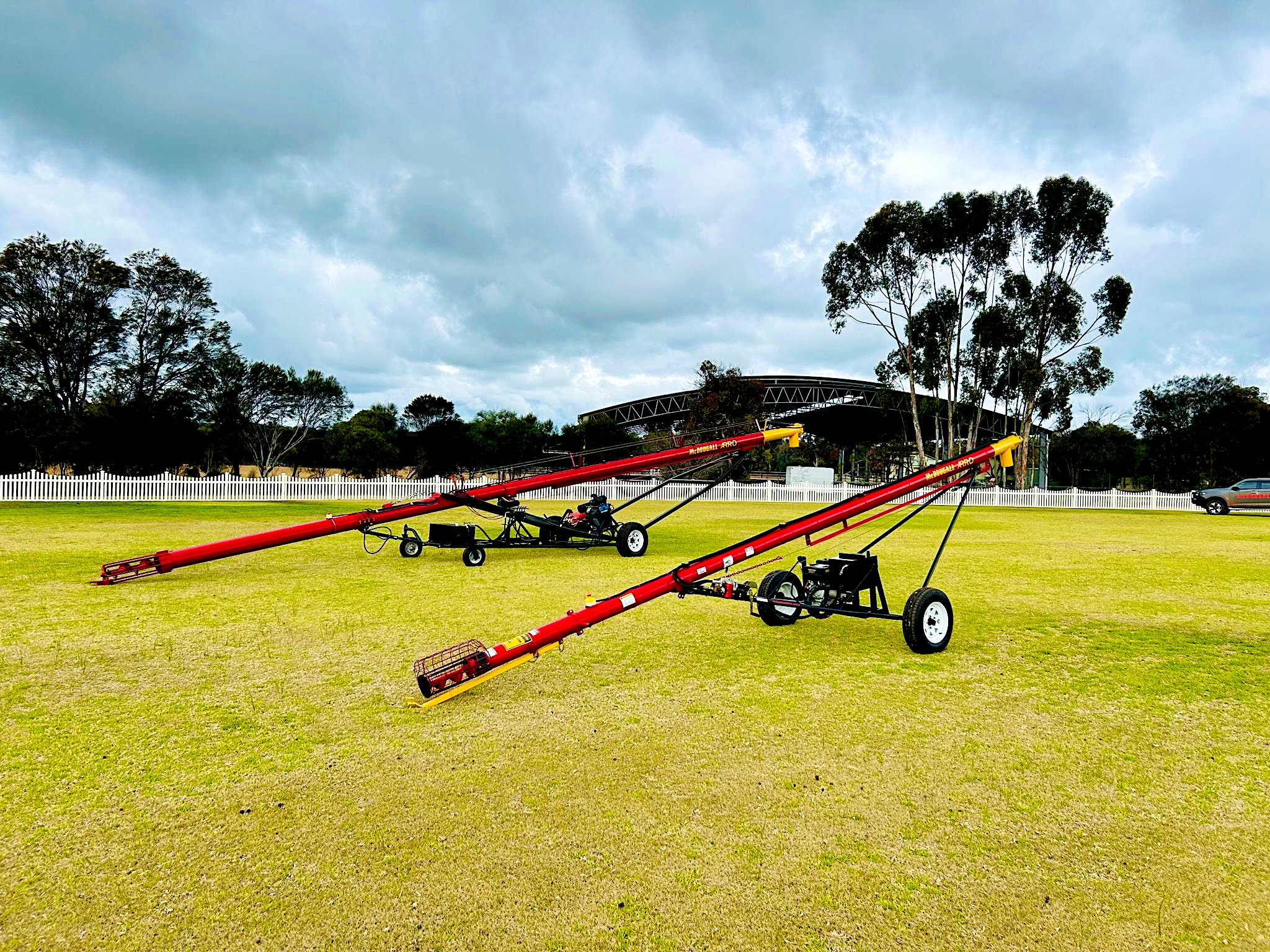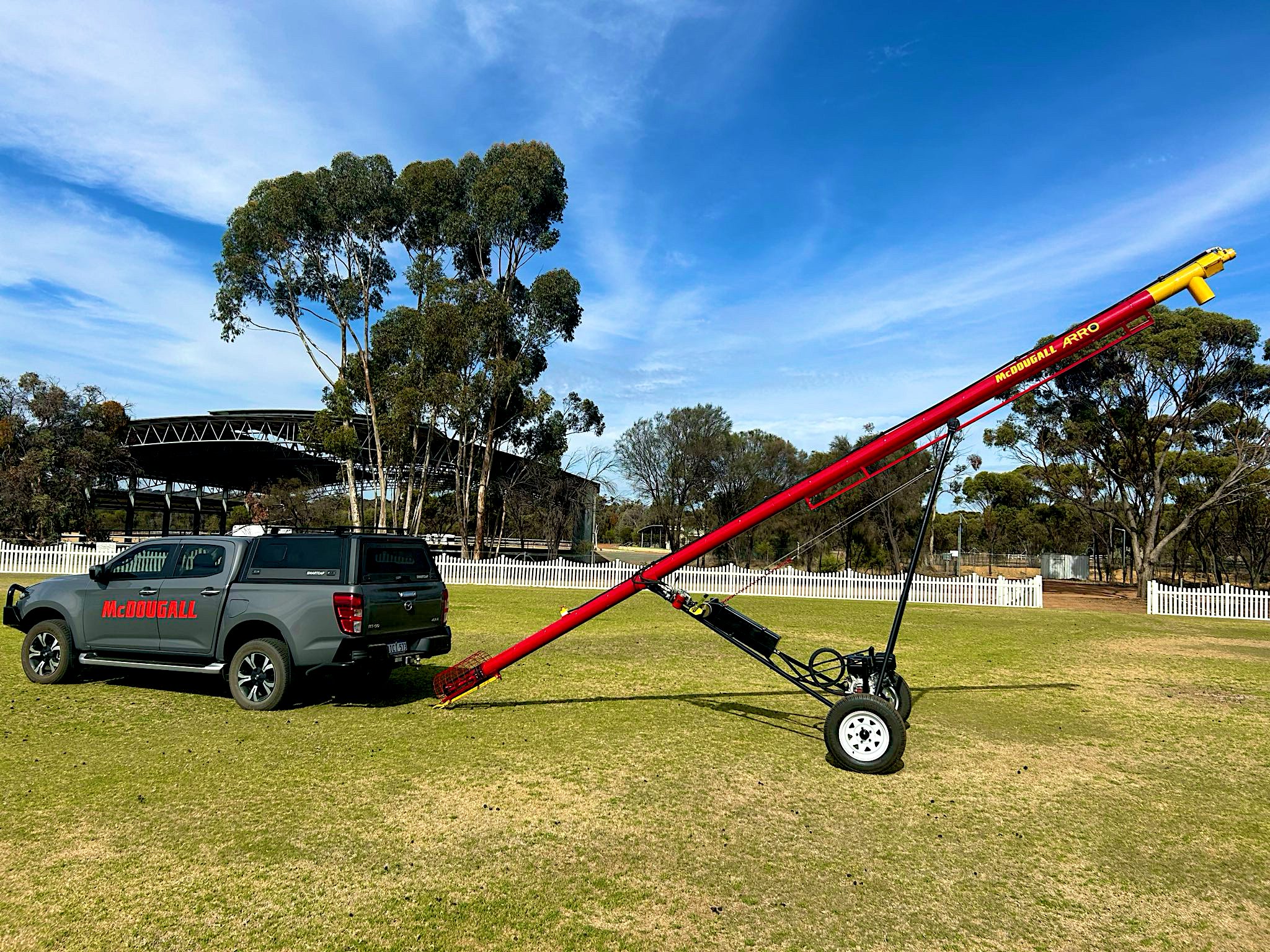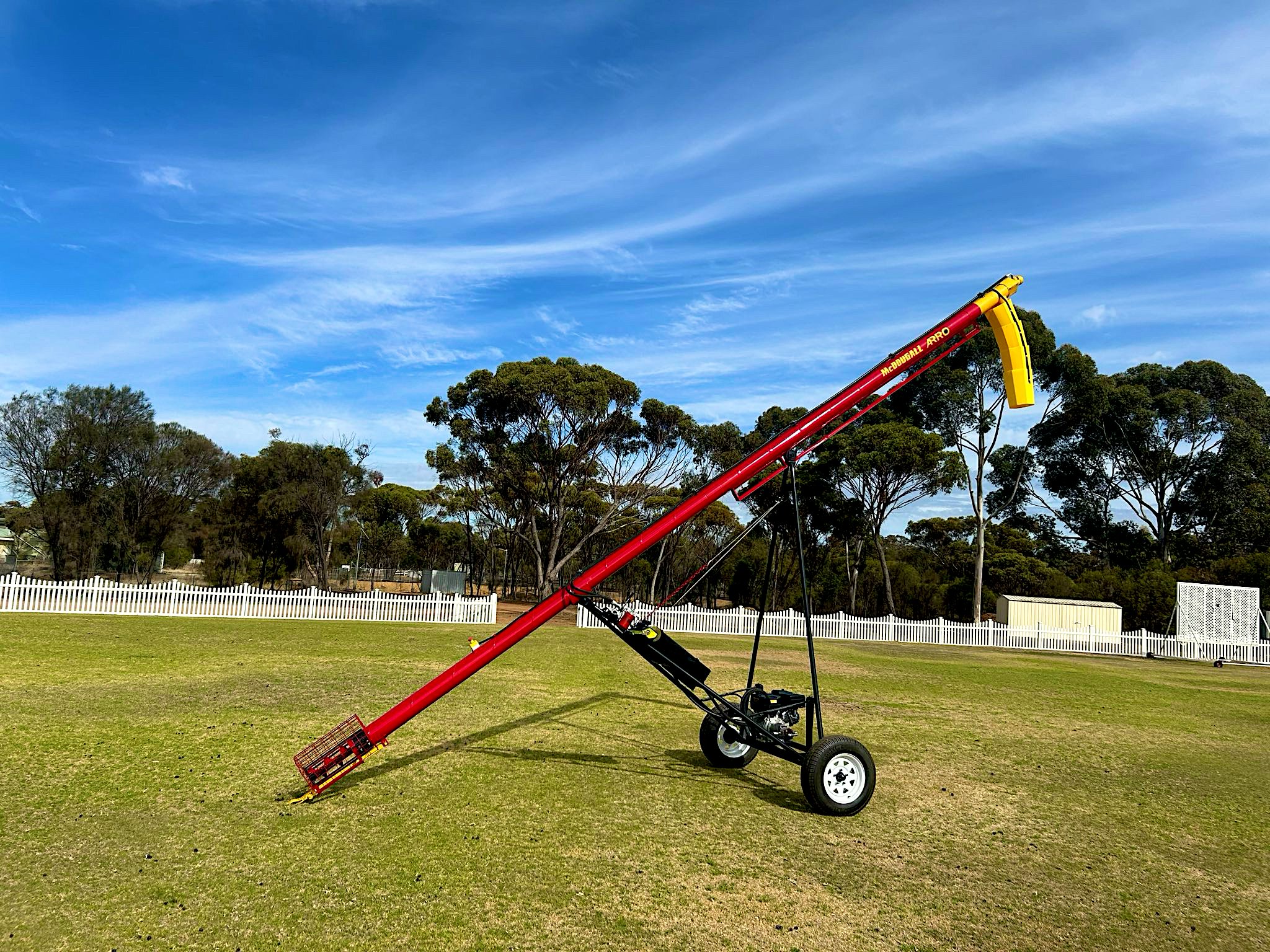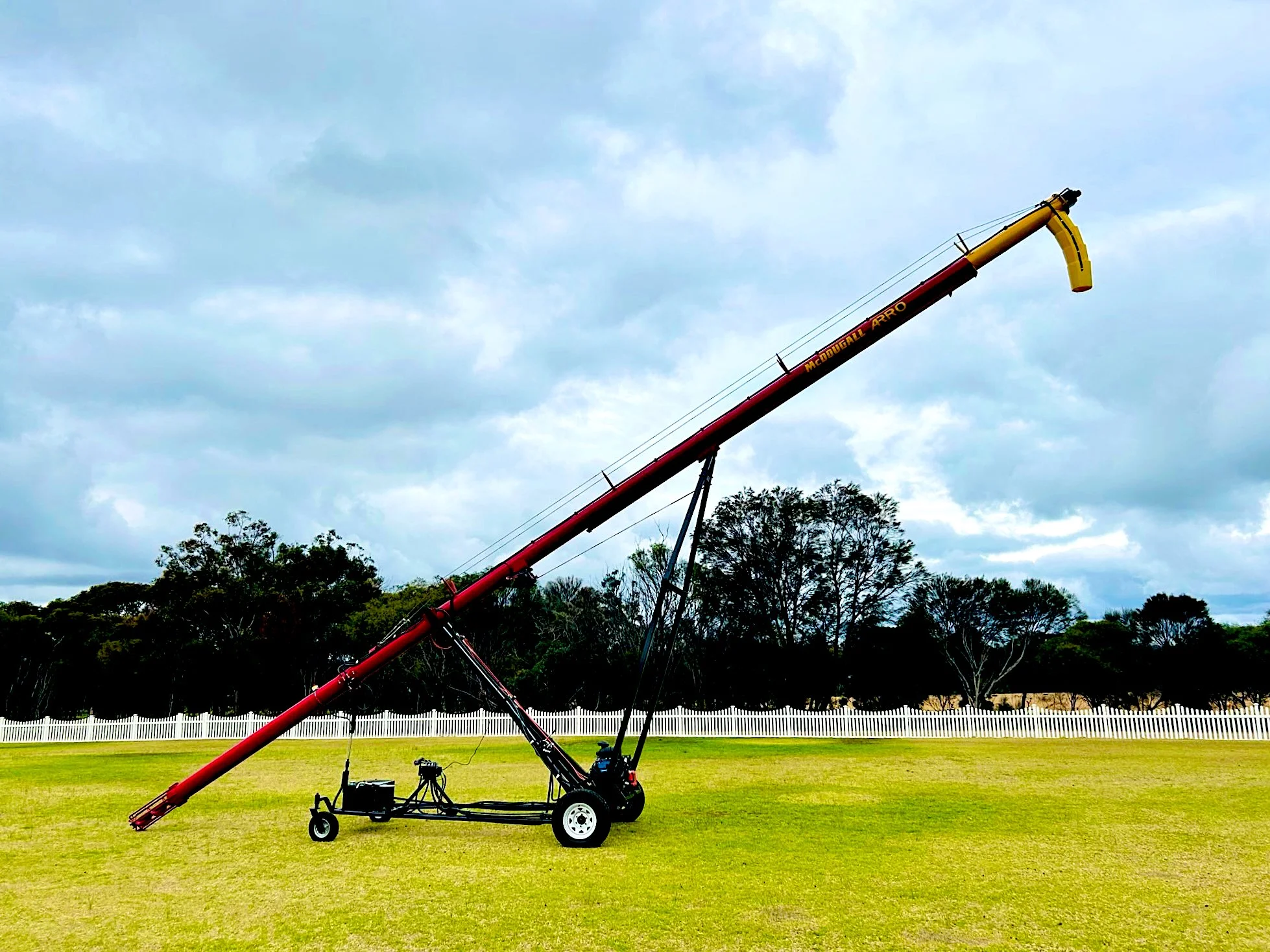MCDOUGALL ARRO AUGER RANGE
62’ 52’ 42’ ARRO AUGERS
AUGER BARRELS VAILABLE IN 10” 9” 8” & CUSTOM
Australian Manufactured Product
McDougall Weldments Quality / Certified
Quality Petrol Engine
Low Maintenance Hydraulic System
Transportable (towable)
Hydraulic Self Drive
Hydraulic Flighting Drive
Hydraulic Reversable Drive
HD Electric Winch Leveling/Height Adjustment
Hydraulic Intake Adjustment
Steel Barrell
Steel Flighting with reenforced lower section
RHS Heavy Duty Chassis
Painted McDougall red/black with safety yellow tip
Safety Guard, Switches and Signs
Drop Shute
26’ ARRO AUGERS
AUGER BARRELS VAILABLE IN 6”
Australian Manufactured Product
McDougall Weldments Quality / Certified
Quality Petrol Engine
Low Maintenance Hydraulic System
Transportable (towable)
Unmatched balanced design for manouverabillity
Hydraulic Flighting Drive
Hydraulic Reversable Drive
Hand Winch Leveling/Height Adjustment
Steel Barrell
Steel Flighting with reenforced lower section
Heavy Duty Chassis
Painted McDougall red/black with safety yellow tip
Safety Guard, Switches and Signs
Drop Shute







Mastering Efficiency: A Guide to the Power of Fast Flow Augers
Are you ready to revolutionize your workflow and take efficiency to the next level? Look no further than our comprehensive guide to the power of fast flow augers! In today's fast-paced world, time is money, and optimizing your operations can make all the difference. Fast flow augers are the unsung heroes that can streamline your processes, boost productivity, and maximize output like never before.
Imagine a tool that not only accelerates the flow of materials but also simplifies complex tasks, saving you time and effort on every project. Whether you're in agriculture, construction, or manufacturing, mastering the art of fast flow augers can give you a competitive edge in your industry. From increasing throughput to reducing downtime, these powerful tools are a game-changer for any operation looking to supercharge its efficiency.
Join us as we delve into the world of fast flow augers and discover how they can transform your workflow from average to outstanding in no time!
Understanding Fast Flow Augers
Fast flow augers are specialized tools designed for the efficient movement of various materials, primarily in industries such as agriculture, construction, and manufacturing. Unlike traditional augers, fast flow augers are engineered to enhance the speed and consistency of material transfer, making them invaluable for operations that require rapid processing. The design typically features a larger diameter and a more aggressive flighting pattern, allowing for greater volumes of material to be moved in a shorter time frame. This efficiency is achieved without compromising the integrity of the materials being transported, ensuring that quality remains intact throughout the process.
The operation of fast flow augers is relatively straightforward. They utilize a rotating helical screw blade, known as a flight, to move materials along a tube or trough. The rotation of the screw creates a pushing force that propels the material forward, significantly reducing the time required for transport compared to manual methods or less efficient machinery. This mechanism is particularly effective for bulk materials, such as grains, sand, and aggregates, where quick and reliable movement is essential.
In addition to their speed, fast flow augers are often equipped with advanced features such as adjustable flow rates, variable speed drives, and integrated sensors for monitoring performance. These innovations allow operators to customize the auger's operation to meet specific demands, further enhancing efficiency. Understanding these fundamentals is critical for anyone looking to implement fast flow augers in their operations, as it lays the groundwork for recognizing their advantages and applications in various industries.
Advantages of Fast Flow Augers
One of the primary advantages of fast flow augers is their ability to significantly increase throughput. By facilitating the rapid transfer of materials, these augers minimize delays in production processes, allowing businesses to meet tight deadlines and improve overall productivity. This is particularly beneficial in environments where time-sensitive operations are critical, such as during harvest seasons in agriculture or in projects with strict timelines in construction.
Fast flow augers also contribute to reduced labor costs. With their efficient design, these augers can often replace manual labor or slower equipment, leading to lower staffing requirements and decreased operational expenses. This shift not only saves money but also allows workers to focus on more skilled tasks rather than repetitive material handling, ultimately improving job satisfaction and workplace safety.
Additionally, the versatility of fast flow augers cannot be overstated. They are capable of handling a wide range of materials, from lightweight grains to heavier aggregates, without the need for extensive modifications. This adaptability makes them suitable for various industries, enabling businesses to invest in a single tool that can meet multiple operational needs. Overall, the advantages of fast flow augers position them as essential components in modern industrial processes, driving efficiency and effectiveness across the board.
Applications of Fast Flow Augers
Fast flow augers find extensive application across a multitude of industries, showcasing their versatility and efficiency. In agriculture, for instance, these augers are commonly used for the transportation of grains, seeds, and other bulk materials. They are instrumental during harvest seasons, where the rapid movement of crops to storage or processing facilities is crucial for maintaining quality and minimizing spoilage. Their ability to handle large volumes with minimal downtime makes them indispensable in farming operations.
In the construction industry, fast flow augers are employed for transporting aggregates, cement, and other materials essential for building projects. Their robust design enables them to move heavy materials efficiently, which is vital for maintaining project timelines and reducing labor costs. Furthermore, their adaptability allows them to be utilized in various stages of construction, from site preparation to final finishing, ensuring that materials are delivered exactly where and when needed.
Manufacturing operations also benefit significantly from the use of fast flow augers. In this sector, they are often used for conveying raw materials to processing machinery or for moving finished products to packaging areas. The ability to integrate fast flow augers with automated systems further enhances efficiency, enabling seamless material flow and reducing the potential for bottlenecks in production lines. Overall, the diverse applications of fast flow augers illustrate their critical role in enhancing operational efficiency across different sectors.
Factors to Consider When Choosing Fast Flow Augers
When selecting fast flow augers for your operation, several factors must be taken into account to ensure you make the best choice for your specific needs. One of the most important considerations is the type of material you will be transporting. Different materials have varying properties, such as density, flowability, and abrasiveness, which can influence the design and specifications of the auger. Understanding these characteristics will help you select an auger that can handle your materials effectively without causing damage or excessive wear.
Another critical factor is the required throughput or capacity of the auger. It’s essential to determine the volume of material you need to move within a specific timeframe. This information will guide you in selecting an auger with the appropriate diameter, flighting design, and motor power to meet your operational demands. Additionally, considering the layout of your facility and the distance materials need to be transported will help in choosing the right length and configuration for your auger system.
Finally, maintenance and durability should also be key considerations when selecting fast flow augers. Look for models that are built with high-quality materials and designed for easy maintenance, as this will reduce downtime and repair costs in the long run. Options that come with warranties or service plans can also provide additional peace of mind, ensuring that your investment is protected and that you can rely on your augers for consistent performance over time.
Maintenance Tips for Fast Flow Augers
Proper maintenance of fast flow augers is crucial for ensuring their longevity and optimal performance. One of the key maintenance practices is regular inspection of the auger components. This includes checking the flighting for signs of wear or damage, examining the bearings for proper lubrication, and ensuring that all bolts and fasteners are securely tightened. Conducting these inspections on a routine basis can help identify potential issues before they escalate into costly repairs or downtime.
Cleaning the auger regularly is another essential maintenance task. Material buildup can lead to blockages and inefficient operation, so it is important to clear any residue from the auger housing, flighting, and discharge points. Depending on the materials being handled, this may need to be done more frequently. In addition, using appropriate cleaning agents that won't harm the auger's materials is advisable to maintain its integrity.
Lastly, operators should adhere to the manufacturer's guidelines for operational limits, including speed and load capacities. Overloading an auger or running it beyond its designed speed can lead to premature wear and failure. Training staff on proper operation and maintenance procedures is also critical, as knowledgeable operators are more likely to notice and report issues early, thus maintaining the efficiency and effectiveness of the fast flow augers in operation.
Comparing Fast Flow Augers to Traditional Augers
When comparing fast flow augers to traditional augers, the differences in design and functionality become evident. Traditional augers typically feature a simpler design and are often limited in their capacity to move materials quickly and efficiently. They may have a smaller diameter and less aggressive flighting, which can restrict the volume of material that can be transported in a given time frame. This often leads to longer processing times and increased labor costs, which can impact overall operational efficiency.
In contrast, fast flow augers are built for speed and efficiency. Their advanced design allows for a higher throughput, making them ideal for operations that require rapid material transfer. The larger diameter and specialized flighting patterns enable these augers to handle bulk materials more effectively, reducing the need for additional equipment or manual labor. This enhanced performance translates to reduced operational costs and improved productivity in various applications.
Moreover, fast flow augers often come equipped with modern technology features such as variable speed controls and integrated sensors that monitor performance. These innovations allow for greater flexibility in operations and provide real-time data to optimize material flow. Traditional augers, on the other hand, may lack these advanced capabilities, making them less adaptable to the dynamic needs of modern industries. Overall, the comparison highlights the significant advantages fast flow augers offer over their traditional counterparts, particularly in terms of efficiency and productivity.
Innovations in Fast Flow Auger Technology
The field of fast flow auger technology has seen significant innovations in recent years, aimed at enhancing efficiency and performance. One notable advancement is the integration of smart technology, which allows for real-time monitoring and data collection during the auger's operation. These systems can track variables such as flow rate, temperature, and wear levels, providing operators with valuable insights that can inform decision-making and predict maintenance needs. This data-driven approach not only improves operational efficiency but also extends the lifespan of the equipment.
Another innovation is the development of modular auger systems. These systems allow for customizable configurations that can be easily adapted to fit specific operational needs. By using interchangeable components, businesses can modify their augers for different applications without the need for entirely new equipment. This flexibility helps companies respond quickly to changing demands and enhances their overall productivity.
Additionally, advancements in material science have led to the creation of more durable and lightweight materials for auger construction. These new materials not only reduce the overall weight of the augers, making them easier to handle and install, but also improve their resistance to wear and corrosion. This enhancement in durability ensures that fast flow augers can operate effectively in challenging environments, ultimately maximizing their value for users across various industries.
How Fast Flow Augers Improve Productivity
Fast flow augers play a pivotal role in improving productivity across multiple sectors by streamlining material handling processes. By significantly reducing the time it takes to move materials from one point to another, they minimize delays and bottlenecks that can hinder operations. This efficiency is especially crucial in fast-paced environments where every second counts, such as in construction projects or during harvest seasons in agriculture. The ability to maintain a constant flow of materials allows companies to adhere to tight schedules and meet production targets more effectively.
Moreover, the use of fast flow augers often leads to a reduction in labor costs. By automating the material transfer process, companies can decrease their reliance on manual labor, allowing workers to focus on more complex and value-added tasks. This shift not only enhances productivity but also improves worker safety by reducing the physical strain associated with manual handling of heavy materials. As a result, businesses can achieve higher output levels with the same or even fewer resources.
Additionally, fast flow augers contribute to improved quality control in production processes. By ensuring consistent and efficient material flow, they help prevent issues such as material segregation or contamination, which can occur when materials are moved manually or with less efficient equipment. This consistency leads to higher quality outputs, further enhancing a company's reputation and competitiveness in the market. Ultimately, the integration of fast flow augers into operations can lead to transformative improvements in productivity, quality, and profitability.
Industries that Benefit from Fast Flow Augers
Fast flow augers are utilized across a wide range of industries, each benefiting from their efficiency and effectiveness in material handling. In the agricultural sector, these augers are crucial for transporting grains, seeds, and feed, especially during peak harvest times when speed is essential. Their ability to handle large volumes quickly helps farmers reduce spoilage and improve their overall yield, making them an indispensable tool for modern farming operations.
The construction industry also reaps significant benefits from the use of fast flow augers. These tools are employed to transport aggregates, cement, and other materials, streamlining the building process and ensuring that projects stay on schedule. Fast flow augers reduce the need for manual labor and can be adapted for various tasks, from site preparation to finishing work, enhancing overall project efficiency.
Manufacturing is another sector that extensively uses fast flow augers. In this industry, they facilitate the movement of raw materials to processing machines and the transfer of finished products to packaging areas. Their integration with automated systems allows for seamless material flow, reducing downtime and bottlenecks in production lines. Overall, fast flow augers serve as a vital component in numerous industries, driving efficiency and productivity while meeting the unique demands of each sector.
Conclusion
Mastering the use of fast flow augers can significantly enhance efficiency across various operations, providing a competitive edge in today’s fast-paced market. Their ability to streamline material handling processes, reduce labor costs, and improve productivity makes them a valuable investment for businesses in agriculture, construction, manufacturing, and beyond. By understanding the advantages, applications, and innovations of fast flow augers, operators can optimize their workflows and achieve remarkable results.
Incorporating fast flow augers into your operations is not just about upgrading equipment; it’s about embracing a more efficient way of working that can lead to greater profitability and success. As industries continue to evolve and demand higher standards of efficiency, fast flow augers will remain a key player in driving these advancements. By staying informed about the latest technologies and best practices, businesses can ensure they are leveraging the full potential of fast flow augers to master efficiency and thrive in their respective markets.
Add your pricing strategy. Be sure to include important details like value, length of service, and why it’s unique.

